|
2C Update #128 - Suwarrow and
the Cook Islands - July 2005
(Land Photographs
by the Two Captains & UW Photographs by Bud Bliemeister,
sv Passage)
When cruisers die
and go to heaven, Suwarrow will be one of the
destinations available to them. The pass is a tad
dicey, the anchorage (13*14.9S; 163*06.5W) is
full of coral “bommies”, and the only protection is a
small area behind Anchorage Island, but it is hundreds
of miles from anywhere else, the reefs are unspoiled,
the fish free of ciguatera, the breeze (usually) steady
over Anchorage Island, and the only sign of man is the
camp of the official caretakers.
|
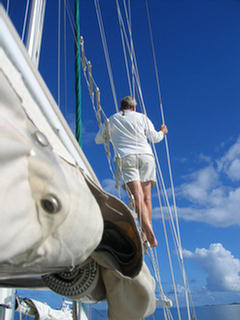 |
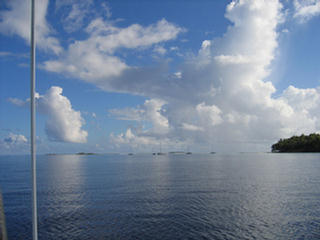 |
An atoll eleven
miles across, Suwarrow is one of fifteen small islands
belonging to the Cook Islands. These islands are
scattered in two main groups over two million square
miles of ocean. Only five of the Cooks have passable
anchorages, and although they lie across the usual
routes west from French Polynesia, they are so spread
apart that most cruisers choose only one to visit. And
a hard choice it is to make. Does one sail SW to
Rarotonga, the lushly mountainous main island and center
of the Cook Is. Culture, and/or nearby Aitutaki? Here
is where most of the Cook Islanders live, and I’ve heard
it said that the Cook Island dancers are the best in
Polynesia. Or there is the fascinating Palmerston
Island a little closer to the rhumb line from Bora Bora
to Tonga. Reknowned for their hospitality, all
Palmerston’s inhabitants are descendants of one
Englishman who settled on the island in 1862 with three
Cook Islander wives and with them fathered 26 children!
Alternatively, one could tack way north to visit the
less-visited and more tropical Penryhn Atoll?
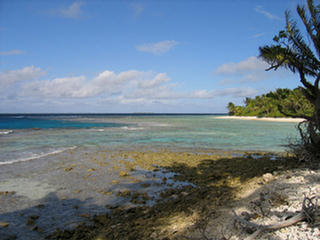 Or do you choose the
uninhabited atoll Suwarrow? Originally called Suvarov
after the Russian ship that first visited it, Suwarrow
was made famous by a book called An Island to Oneself,
by New Zealander Tom Neale. Neale lived the hermit’s
life on Suwarrow’s Anchorage Island from 1953 to 1978,
charming the occasional yachties that found their way
there, and thereby founding one of those nautical
traditions that is irresistible to seafarers. Perhaps in
recognition of this lure, the Cook Island government
made Suwarrow a nature preserve and bird sanctuary with
a caretaker/parkwarden stationed on the island, much
less as a government official, than as a host to carry
on Neale’s role. Or do you choose the
uninhabited atoll Suwarrow? Originally called Suvarov
after the Russian ship that first visited it, Suwarrow
was made famous by a book called An Island to Oneself,
by New Zealander Tom Neale. Neale lived the hermit’s
life on Suwarrow’s Anchorage Island from 1953 to 1978,
charming the occasional yachties that found their way
there, and thereby founding one of those nautical
traditions that is irresistible to seafarers. Perhaps in
recognition of this lure, the Cook Island government
made Suwarrow a nature preserve and bird sanctuary with
a caretaker/parkwarden stationed on the island, much
less as a government official, than as a host to carry
on Neale’s role.
I, of course, wanted
to do it all, and some boats do, starting south in
Rarotonga and then working their way north all the way
to Penryhn. But, there is so much to see to the west
before the next cyclone season, that we, like most
cruisers, realized we had to pick just one, and, after
all our time in French Polynesia, the retreat to nature
called strongly to us. So many of our diving friends in
last year’s group had written glowingly of Suwarrow and
it’s long-time caretaker Papa Joane, it just seemed too
special to miss.
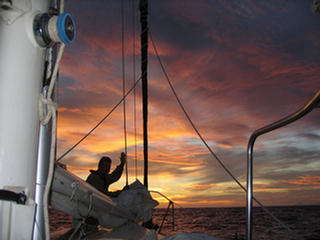 Should in fact I get
to yachtie heaven, I do hope that the nasty passages are
somehow excised from the experience. I know… I know,
those are the parts that make the arriving sweeter, but
both these two captains and almost every other cruiser
we talked to in Suwarrow could do quite happily without
the shakedown we underwent for three of the six days it
took to reach the atoll from Bora Bora. Our course
carried us through a northern branch of the South
Pacific Convergence Zone (SPCZ), where equatorial
north-easterly winds bump into the southeast trades. We
alternately experienced high winds, no winds, confused
seas and heavy rain, making for a generally unpleasant
passage. We had stuff shaken from shelves that had
ridden there uneventfully since the Virgin Islands, and,
as for the leaks, well, it’s just too depressing to talk
about T2’s leaks, the bane of Don’s existence. Should in fact I get
to yachtie heaven, I do hope that the nasty passages are
somehow excised from the experience. I know… I know,
those are the parts that make the arriving sweeter, but
both these two captains and almost every other cruiser
we talked to in Suwarrow could do quite happily without
the shakedown we underwent for three of the six days it
took to reach the atoll from Bora Bora. Our course
carried us through a northern branch of the South
Pacific Convergence Zone (SPCZ), where equatorial
north-easterly winds bump into the southeast trades. We
alternately experienced high winds, no winds, confused
seas and heavy rain, making for a generally unpleasant
passage. We had stuff shaken from shelves that had
ridden there uneventfully since the Virgin Islands, and,
as for the leaks, well, it’s just too depressing to talk
about T2’s leaks, the bane of Don’s existence.
Our last day was
fine sailing, of course, at least until nightfall when
it went dead calm. We hove to for the night about
twenty miles out, well clear of the atoll’s eastern
reefs, and at about 5 AM fired up Perky to motor on in
in time for slack tide and good light in the pass.
During the night, two other boats we’d not known were
out there materialized out of the dark, and the three of
us entered the pass one behind the other and found
places to drop the hook in between the four boats
already there.
The day after our
arrival, John and Veronica, the new caretakers of
Suwarrow invited all the boats in the anchorage ashore
to a “light lunch” of fresh-caught tuna, poisson cru,
breadfruit, and coconut pancakes, the first of several
group feasts.
How can I capture the natural warmth with
which John and Vero welcomed us to this mid-ocean Eden?
Imagine being a lone couple, plopped for six months on
an island hundreds of miles from family and friends,
essentially camping out and,
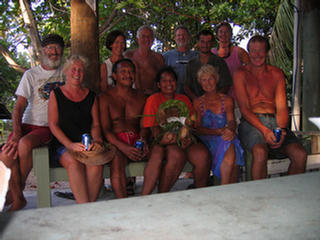 not unlike charter
captains, finding themselves reaching out over and over
to constantly changing visitors of varied nationalities,
not to mention different languages! Plus, they had to
be aware that they were replacing a well-loved figure –
Papa Joane – who retired this year. not unlike charter
captains, finding themselves reaching out over and over
to constantly changing visitors of varied nationalities,
not to mention different languages! Plus, they had to
be aware that they were replacing a well-loved figure –
Papa Joane – who retired this year.
Papa Joane, who it
turns out is Vero’s uncle (for a nice bit of
continuity), came up with them at the beginning of the
season to show them the ropes…what birds nest on which
island and which critters lurk on which reefs.
The rest
of the required skills – from fishing, to catching
coconut crabs, to weaving anything and everything from
palm fronds – seem to be things every Cook Island child
grows up knowing how to do.
During the ten days we
stayed at Suwarrow, we saw John and Vero wear many hats:
park warden; tour guide; custom and immigration
official; teacher, and musician, but the one that fit
most comfortably was that of host.
In one stop we
forged the kind of bonds we’d been looking for since the Marquesas.
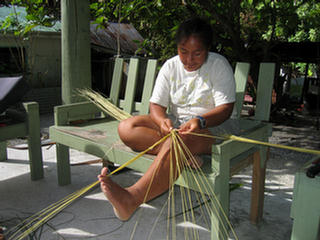
It’s amazing how you
can fill your time in a place like Suwarrow, even
considering that, thanks to a spate of high winds, our
adventures were confined to the reefs near the
anchorage. Even though waves were breaking under the
dinghy, we dove a half dozen times in clear warm water
on lovely reefs full of fish and many varieties of
shellfish. We trolled for dinner from the dinghy, and
Don even got to break his spear-gun out of mothballs for
a few forays, although the patrolling sharks and rolling
seas made for a more adventurous exercise than he and
his hovering tender really wanted… We went back to
trolling!
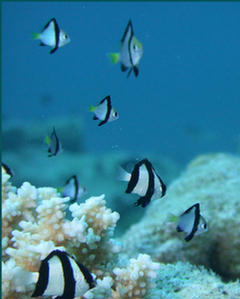 Ashore, we walked
beaches and coconut groves, consumed coconuts at every
stage of the nut, and learned from Vero how to make her
yummy coconut pancakes, made from the coconuts that have
begun to sprout. Ashore, we walked
beaches and coconut groves, consumed coconuts at every
stage of the nut, and learned from Vero how to make her
yummy coconut pancakes, made from the coconuts that have
begun to sprout.
One afternoon that spoke to my soul
was spent sitting on a fallen palm trunk in the dappled
shade of the coconut grove with Marie Christine, a
French lady doctor, singlehanding. We learned from Vero to
make palm-frond roof tiles for the beach palapa that John and
several cruisers were restoring, which, of course, had
to be christened with a big potluck when it was done.
And finally, when the wind eased just a bit, John and
Vero carried us in their skiff to Gull Island to see
nesting frigates, and, particularly special to me, an
up-close view of a nesting tropic bird.
We might easily have
stayed half the season in Suwarrow, but another group of
this season’s Puddlejumpers arrived, with more not far
behind them, and the anchorage was growing crowded. It
seems more and more cruisers are making Suwarrow the
Cook Island of choice. Plus a weather window of steady,
if strong, easterlies was forecast, which seemed ideal
for carrying us on our next leg to American Samoa.
But
leaving was hard… With John and Vero as ambassadors of
their country, our visit to Suwarrow sure has made me
wish to see more of the Cooks. With 20-20 hindsight I
regret not being one of the boats that tried to do it
all.
|